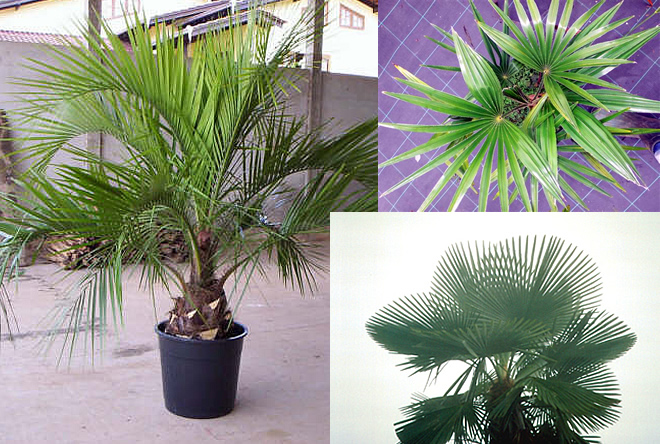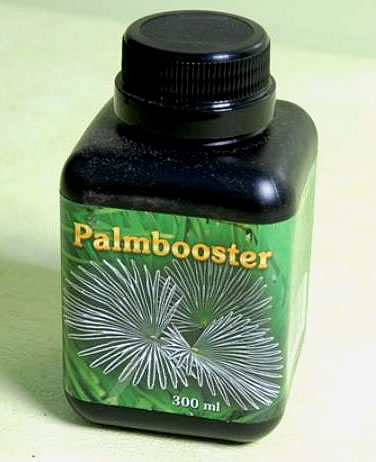- Large and unique assortment
- Quick delivery all over Europe
- Your specialist in exotic plants and trees
You have nurtured your palm from seed or seedling, or received and planted your magnificent Trachycarpus wagnerianus (Windmill palm). Possibly you got your Trachycarpus princeps blue-silver, Trachycarpus takil, or maybe a feather palm. You followed our advice regarding 'growing palms', by giving your new palm a good drink of Palmbooster and now you have retired beneath the palm fronds with a beer or a cup of tea. What is next?
As we have said on our other pages, our palms are selected carefully for you from nurseries all over the world where the palms are accustomed to climates similar to our own. All we have to do now is understand how the plant grows, what its needs are and how to protect it in more severe weather.

We are frequently asked how much food a palm tree should receive. This is dependent on many things: the type of palm, its size and the circumstances in which it is living. In particular, plants in pots or containers can quickly become undernourished. We would strongly recommend use of the Fertometer, a device which enables you to measure the nutrient levels in your pot.
A palm should be fed well during its growing season. You'd be surprised how hungry a palm can get! Use a propriatary palm fertilizer and mix in some general fertilizer (NPP 3-1-2). If you scatter a little potash next to the trunk in the autumn you will help the plant prepare itself for winter.
A word of warning. Be careful to distribute fertilizer on the ground only; if you spill onto the plant itself you can cause 'burns' and damage the growing point (spear) of your palm.
As for general compost; modern thinking suggests that if we enrich the soil too close to the root ball the roots become lazy and don't develop. You are better off mulching your plant substantially with wood chippings, lawn cuttings or other organic matter in a large area arond the root so that the food is distributed evenly and the roots are encouraged to develop well. And you will find that as the roots develop well, the top foliage and trunk will benefit in a year or two.

A palm needs to establish its roots first. Only when they have developed adequately does frond development take place. We've already mentioned Palmbooster as the solution for ensuring root development after planting or transplantation. We would recommend continuing applying this excellent treatment throughout the life of the plant at a reduced dosage. Excellent results are achieved with products such as Palmbooster if applied regularly and well. Most palm roots are still growing late in the year when foliage has apparently stopped - keep giving your palm the necessary attention even in this period and you will be well rewarded later on!
Most palms like a lot of water. If you ensured adequate drainage around the root ball as is suggested, it would a good idea to create a sort of saucer to trap water round the root by making a rim of soil around 40cm from the trunk. This will then funnel the water to the roots and the drainage trench will ensure the roots don't get waterlogged. Ideal conditions for your palm!
When considering hardiness we tend to think mainly of cold-hardiness. Many people are unaware of two other main players in winter; the wind and the fact that winter is usually very dry! Cold in combination with wetness is often a killer; simply by thinking things through and protecting adequately you can achieve surprising results with your palms.
It is important not to use plastic foil or bubble wrap to protect the top of your plant. It's essential that the plant breathes well; if you cover it up with foil it will simply suffocate and rot!
See our extensive range of winter-protection!
Check our advice as to what temperatures your palm can tolerate. If the temperature is going to drop below the level at which you should start protecting your palm, you should act as follows:
First wrap the leaf crown with garden fleece, if necessary twice, then wrap the trunk with bamboo mats. Tape the fleece overhang to the bamboo mats. Finally, cover the ground to about 50cm around the trunk with a generous mulch of, for example, pine needles. Do not over protect! Once a cold snap has passed, unwrap the palm as appropriate and let it breathe.
Just as any other living organism, your palm is subject to attack from a selection of life's nasties. Here is a quick troubleshooter guide for several more common issues:

The spear is the growing point of the palm and the most vulnerable part. This can appear rotten (worst case scenario: it just lifts away if you pull it upwards). This can have a number of causes:
In general, it's a good idea to pull the spear of your plant in the spring and to remove any dead leaves; by doing this you can prevent the spread of the rot further into the crown of your plant.
Leaves often brown during a warm period following a cold winter. It is an indication that the leaves have not been optimally cared for; see our tips above. Of course, prevention is better than curing! Be consoled with the fact that new leaves are made each year!
If you follow our advice you should enjoy a fine, healthy palm for many a year!
© MyPalmShop.com 2019